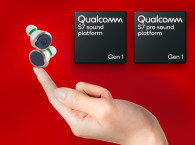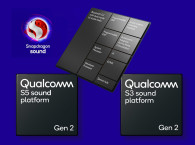
A short time after the launch of the new cutting-edge S7 and S7 Pro Gen 1 Snapdragon Sound platforms, Qualcomm Technologies International now revealed an update series of S5 and S3 Gen 3 platforms, taking the development possibilities for OEMs to a whole new level. Together with the newly introduced S7, these updated sound platforms offer the most powerful ever architectures and resources to elevate true wireless earbuds, headphones and speakers.
The first company to confirm the launch of a product based on the new Gen 3 platforms is vivo Mobile Communication Co., Ltd, the Chinese consumer technology brand headquartered in Dongguan City, Guangdong. "We are excited to soon introduce the world’s first device powered by Qualcomm S3 Gen 3 sound platform," says the company. "By utilizing this powerful platform, we are bringing audiophile quality music listening to our customers, so they can hear their music exactly as the artist intended. Stay tuned for the launch."
The Detailed Specs
The S5 Gen 3 Sound Platform introduces a new multicore architecture combined with enhanced development tools for richly featured devices and uses the same development tools as the new S7 Sound Platforms. It brings powerful 4th Generation Qualcomm Adaptive ANC to the S5 tier, and also supports the Snapdragon Sound Technology Suite for lossless music streaming as well as robust, low-latency sound. Powerful on-device AI can enhance the sound experience across many different use cases, with the data processed locally on device for enhanced security and peace of mind, while a dedicated processor for AI and enhanced power management ensures optimal performance and user experience with minimal battery drain.

This new platform architecture was designed for high-performance audio combined with low power consumption, and unlocks a new tier of performance for premium devices, with 50% more memory and 2x more audio DSP compute than the Qualcomm S5 Gen 2 Sound Platform. The Bluetooth 5.4 radio supports Bluetooth LE Audio and Auracast Broadcast Audio and is combined with a new high-quality stereo DAC and a USB High-Speed PHY at 480 Mbps, which unlocks enhanced Audio Development workflows, allowing low-level debug through use of Qualcomm USB-EUD. DMIC, I2S, TDM, and Soundwire digital audio interfaces are integrated with a fully integrated system including PMU, charger, mic bias, flash memory, and external supply support.
The new S3 Gen 3 devices are a family of flash-programmable Bluetooth audio System-on-Chips (SoCs) based on an ultra-low power architecture that includes options to support Bluetooth LE Audio, Auracast Broadcast Audio, lossless music streaming, and robust connectivity. The Qualcomm QCC3083, QCC3084, and QCC3095 devices all bring LE Audio support alongside classic Bluetooth. aptX Adaptive is available on the QCC3044, while aptX Lossless is available on QCC3083 and QCC3084 to support 16-bit 44.1kHz lossless audio. The new QCC3095 now supports also aptX Lossless at 24-bit/48kHz introducing a new level of sound quality in true wireless, combined with an improved DAC. Qualcomm Active Noise Cancellation (ANC) is available on the QCC3044, QCC3084, and QCC3095 devices.
The SoC architecture includes two dedicated, programmable 32-bit application processor subsystems and a configurable Qualcomm Kalimba DSP, programable using a familiar audio development kit (ADK) and enhanced development tools. Like in previous generations, Qualcomm provides different packages in the S3 Gen 3 Sound Platform for True Wireless Earbuds and Stereo Headphones and Speakers. While for TWS the smallest size is needed, for stereo and speakers a bigger package is bit easier to work with on a PCB, and offers more I/O.

Meeting New Consumer Requirements
To better understand the announcements, audioXpress discussed the motivations behind the new S5 and S3 Gen 3 platforms with John Turner, Senior Director, Product Management Voice and Music at Qualcomm Technologies International.
"Every year we do a consumer survey where we ask consumers about their buying decisions for headsets, speakers, earbuds, and so on. Two things really stood out this year. The first one was around audio quality. Consumers at every tier really valued audio quality and are using that as a purchase driver to improve that generation upon generation, you know even down to the mid tier. And the second one was that consumers are moving away from buying headsets for single purpose. So they're not looking to buy a headset for doing Teams calls in a different headset for sports, a different headset for music and ANC and travel. They want one headset that does it all. So these two things combined are making OEMs want to improve audio quality, but also find ways to differentiate and expand the feature set that's offered by their headphones. So, with that in mind, we're bringing two new sound platforms: the S5 Gen 3 and the S3 Gen 3."

"The S3 Gen 3 sits in the mid-tier and the S5 Gen 3 sits in the premium tier below the Ultra Premium S7 that we launched six months ago. The S3 Gen 3 is based on an existing mature platform, using the Kalimba DSPs. But we've done two key things here to try and respond to that consumer feedback. The first is around audio quality and we've improved our DAC. This is a hardware change where we've improved our SNR by 5dB and we get the noise floor down. With certain drivers, you really don't want to be picking up a kind of faint hiss. So we've put a lot of attention there.
"We've also created a new version of Snapdragon Sound with 24-bit/48kHz lossless music streaming. So that works over Bluetooth LE, like the old version, but we've gone from 16-bit up to 24-bit, so this is now high resolution.
"The second thing, which is kind of the real big deal about this platform, is the amount of flexibility we're offering in this tier. Our previous S3 platforms have been quite limited in what you could do with them as a developer. We allowed developers to change application code, but the DSP - the audio processing contents - were fixed to things that were provided by Qualcomm. And the reason for that was because the customers that tend to operate in this tier don't have the internal expertise to write lots of DSP code. Typically they have small teams.
"Those OEMs are now finding themselves in a crowded sea of devices that all look the same, behave the same, have the same KPIs, have the same look and feel, and they're kind of constrained when they're looking to offer support for lots of different use cases. So we've added flexibility to make it easier for them to integrate new features through our extension program.

"Our extension program is an ecosystem of over 50 members who create components for the Kalimba DSP and also other components that run on the platform. And now we're allowing components from this ecosystem to run on the S3 Gen 3 platform and provide a set of off-the-shelf components for OEMs to easily integrate and create end products from with new features - whether it's different speech processing algorithms, things like sound personalization or hearing tests, hearing assistance, spatial audio, different health solutions, voice assistants, etc. There's a lot of different solutions out there that they can now access and integrate on this platform and take that into the mid-range.
"And we've got an improved adaptive ANC that changes the attenuation curve depending on how much leak-through is happening. We've also got ML-based Deep Convolutional Networks (DCNs) that we've brought in this tier. So it's very capable of picking up people's voices rather than ambient noise.
"As for the S5 Gen 3, this is an update to the premium tier, but this is a completely new platform that actually looks similar to the S7 platform that we introduced several months ago. This is moving away from the Kalimba DSPs and the legacy architecture to provide a much more capable compute architecture targeted for OEMs who want to innovate themselves and do a lot of DSP processing, sensor processing, and ML processing themselves.
The platform has a very similar developer experience to the S7. We've tried to make those common because we sell both platforms to similar customers who want to share code between them. This one sits right underneath the S7 but it is still a significant step up from where we were with the S5 Gen 2, with double the audio processing, and 50 times the ML capability in terms of the amount of GOPS. Overall, when you add up all the compute power - because there are more calls than just audio processing - it's about three times where we were with the Gen 2, and it's got about 50% more RAM as well. So very capable to allow OEMs to innovate.

When asked to compare the level of performance of the new S5 Gen 3 platforms with the recently introduced S4 platforms, John Tuner confirmed: "Compared to the new S7, the S5 Gen 3 platform is about half the compute power, making the S7 really the ultimate compute platform for an earbud. And of course, S7 supports XPAN, which is not the case for S5. We're also bringing across the fourth generation of our ANC solution that incorporates not just a huge increase in the number of ANC filters from where we had before. This means five times the number of ANC filters that we've got in Gen 2. But we also have the very low latency DSP that can be used for audio curation and sound amplification, hearing assistance type use cases as well. So we've brought that across from the S7.
"We're very committed to bringing the best sound experience to our customers, whether it's in the ultra premium with the S7, or the premium with the S5, and the mid-tier with the new S3. Across all tiers, OEMs are trying to differentiate, and we're trying to provide the easiest and the broadest way for them to do that. Whether it's by giving them tons of compute power in the premium and the ultra-premium, or ways to leverage off-the-shelf solutions in the mid-range," Turner concluded.
You can find more information about the Qualcomm Voice & Music Extension Program here.
https://www.qualcomm.com







